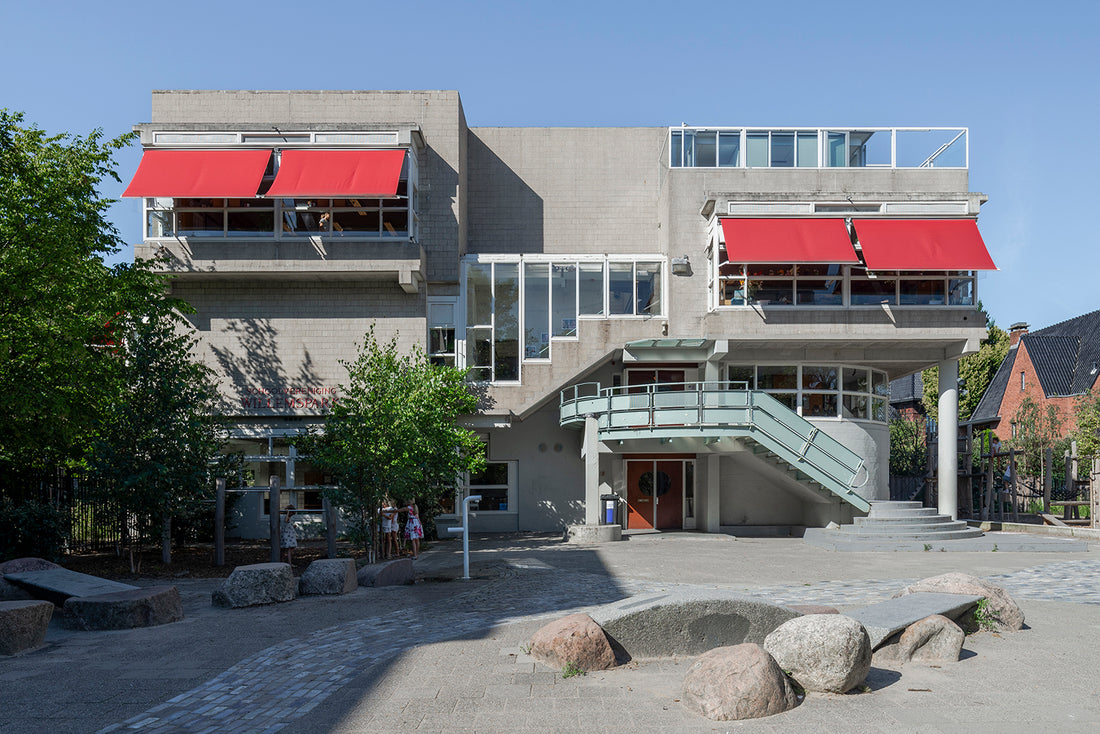
Amsterdam Modern Architecture Walking (or Cycling) Tour
Share
To celebrate the release of our new Modern Amsterdam Map, author Rixt Woudstra has written a walking tour along one of her favourite routes. Photography by Loes van Duijvendijk. The Modern Amsterdam Map is available to purchase here.

Barend van den Nieuwen Amstel, The New House, 1928
Roelof Hartstraat 50
The New House was conceived as an experiment in modern living, with 188 light apartments for single, relatively well-to-do men and women. Its residents could make use of shared facilities such as a library, a roof terrace, a storage space for bicycles, and a dining room where the building’s staff served meals. Designed by the architect Barend van den Nieuwen Amstel for the housing cooperative ‘De Samenwerking’ (‘The Collaboration), the seven-storey red-brick structure with its curved balconies is a particularly imposing example of Amsterdam School architecture. Two protruding, rounded corners frame the building’s monumental façade. Today, the structure contains a public library, but the apartments are still owned by the same organisation – and single occupancy remains a strict requirement.
The New House stands at the Roelof Hartplein, a square at the edge of Hendrikus Petrus Berlage’s ‘Plan Zuid’ (Plan South), created to extend the city in southern direction in 1917. In contrast with the monotonous nineteenth-century city blocks, Berlage’s urban plan is characterised by long wide streets, green spaces, and a variety of high-quality Amsterdam School housing built from the 1920s onwards. Together with Huize Lydia, the tall, asymmetrical building across the street that was built for single Catholic women and girls in 1927, the New House marks the entrance into Plan Zuid.
Jan Frederik Staal, Housing Block on the J.M Coenenstraat, 1923
Johan Coenenstraat 4-26
From here, follow the Johan M. Coenenstraat. Immediately on your right you can spot a design by the architect Jan Frederik Staal. The four-storey housing block extends all the way around the corner. Compared to the New House’s symmetry and monumentality, Staal’s project is a more modern interpretation of the Amsterdam School. At a first glance, its flat and uniform façade is punctuated only by the bright blue, steel lanterns indicating the building’s stairwells. But look more closely and note the different colour brick used to demarcate the ground floor, the beautifully decorated doors gently arched inwards, and the distinctive typesetting of the house numbers.
Another, better-known project by Staal is the ‘Wolkenkrabber’ (Skyscraper), located in another part of Berlage’s ‘Plan Zuid’. Developed as one of the first high-rises in the Netherlands, it stands at a central crossing in the new neighbourhood. While Berlage planned to build several high-rises, this was the only one ever realised. With its 12-storeys, Staal’s building contained many novel features such as an elevator, central heating, and a garbage chute.

Harry Elte, Raw Aron Schuster Synagogue (formerly Obrecht Synagogue), 1928
Heinzestraat 1
Turn right into the Bartholomeus Ruloffstraat and walk until you reach the Jacob Obrechtsquare. Here you can find the Raw Aron Schuster Synagogue, previously known as the Obrecht synagogue. It was built in the late 1920s by the relatively little-known architect Harry Elte, who had worked for Berlage. The striking brick building reveals the influence of the Amsterdam School as well as the American architect Frank Lloyd Wright, particularly through the juxtaposition between the horizontal and vertical volumes. From the outside, the structure might look dark, but the interiors are brightened through the stained-glass windows designed by Willem Bogtman. After World War II, the building became the centre of Jewish life in Amsterdam.

Willem van Tijen, Mart Stam, Lotte Stam-Beese, Hugh Maaskant, Drive-In Dwellings, 1936
Anthonie Van Dijckstraat 4-12
To get to the next building, return to the Johan M. Coenenstraat. Turn right and cross the bridge. Pay attention to the bridge itself; as another example of Amsterdam School design, it features some interesting granite sculptures by the artist Hildo Krop. Continue straight ahead, cross the Apollolaan, one of the monumental and green avenues of ‘Plan Zuid’, and continue along the Beethovenstraat. Turn right into the Gerrit van der Veenstraat, turn left on the Albrecht Dürerstraat, and then turn right into the Anthonie van Dijckstraat.
The rowhouses at number 4-12 are among the first ‘drive-in’ dwellings in the Netherlands, houses with garages built in on the ground floor - a typology that would become more common in the 1950s. (Sadly, however, the garages no longer exist). Different from the organic shapes and the expressionistic details of the Amsterdam School, these dwellings signify the arrival of functionalism, also known as ‘Nieuwe Bouwen’ in the Netherlands. Simple, straight lines, flat roofs, and large glass windows made possible by a concrete frame. Important here is the close connection between the interior and exterior: the garden in the back can be accessed through an outside staircase from the living room on the first floor.
Two of the architects, Mart Stam and his wife, Lotte Stam-Beese, had previously been associated with the Bauhaus. Before coming to the Netherlands, they spent time in the Soviet Union where they were involved with projects such as the design of the industrial city of Magnitogorsk. Stam-Beese, like the other two architects of the drive-in dwellings, Willem van Tijen and Hugh Maaskant, would play a significant role in the post-war reconstruction of the Netherlands.

Jan Duiker, Open-Air School, 1927-1930
Cliostraat 40
Around the corner, in an interior courtyard, stands the famous open-air school designed by Jan Duiker. Take the Quinten Massijsstraat, turn right into the Cliostraat, and peek through the schoolyard’s gate to admire Duiker’s masterpiece. Officially known as the ‘First Open-Air School for the Healthy Child’, the project aimed to optimise children’s exposure to the sun to improve their health. It is situated diagonally within the courtyard and consists of various square, concrete slabs held up by thin columns. The classrooms are cladded by glass, while multiple terraces allow for outside education. It remains in use as an elementary school.
Hein Salomonsen, Villa Orlow, 1961
Apollolaan 141
From there, walk to the end of the Cliostraat and turn right into the Rubensstraat. At the corner of the Rubensstraat and the Apollolaan, you can see House Orlow. This private residence was designed in the early 1960s by the architect Hein Salomonsen and can be considered an example of Dutch post-war modernism. Like Le Corbusier’s Villa Savoye, the living room and bedrooms are raised off the ground. The roof terrace offered House Orlow’s residents, the affluent owners of a tobacco factory, a free view across the Berlage’s green neighborhood. The garden (hard to see from the street) was designed by the well-known landscape architect Mien Ruys.

Herman Hertzberger, Apolloschools, 1980-1983
Willem Witsenstraat 12-14
The final two buildings on this tour are the schools designed by architect Herman Hertzberger in the 1980s. Walk past Hugh Maaskant’s 1960s concrete Hilton Hotel on the Apollolaan and turn right into the Willem Witsenstraat. On a large plot, you can see two free-standing buildings: the Montessorischool on the left and the Willemsparkschool straight ahead. Both schools, made of concrete blocks, contain central, open atriums with split-level classrooms. Hertzberger designed various schools during his long and successful career and aimed to stimulate social interaction through architecture. Here, the interior central space functions like an informal meeting area, with different corners and spaces for study or play.
Explore more Modern architecture in Amsterdam with our map here.

